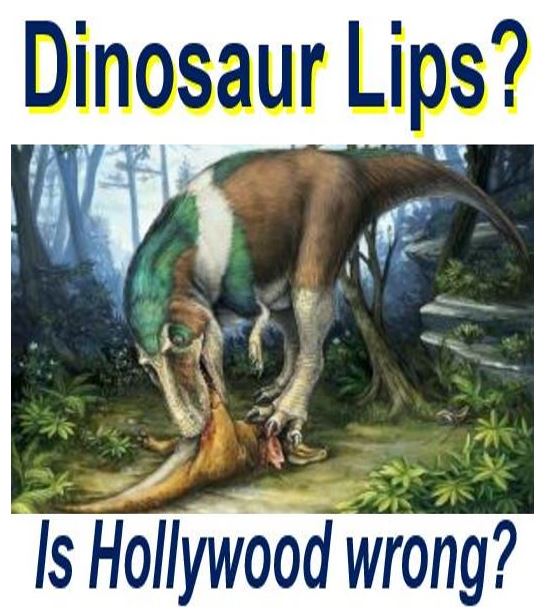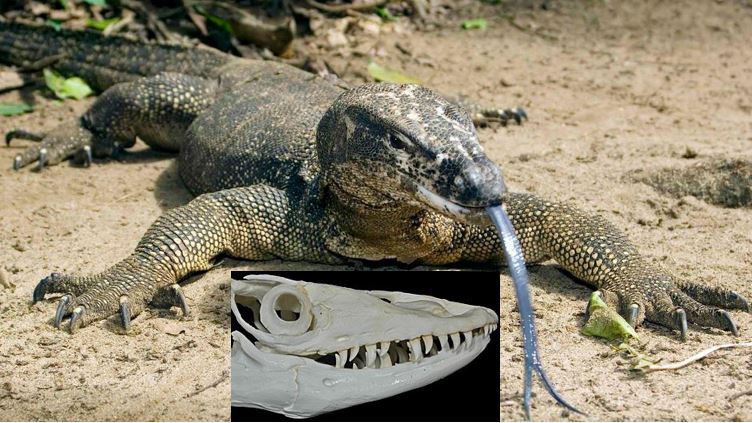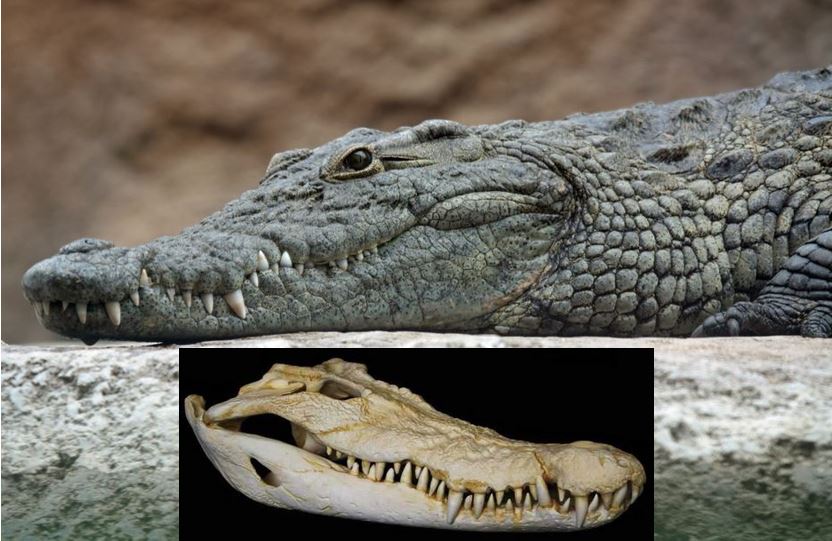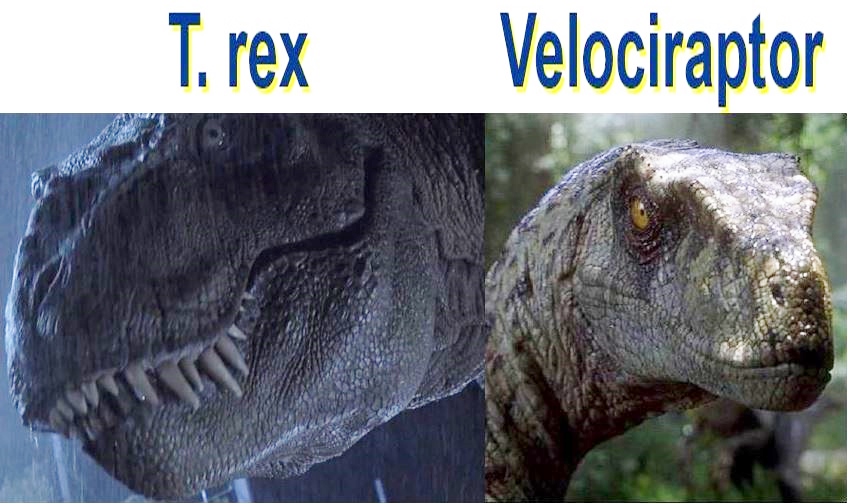Dinosaurs had lips, probably, says a University of Toronto palaeontologist, who believes that theropods may have looked different from what we have been led to believe. Theropods, also known as bird-footed dinosaurs, were carnivorous dinosaurs of a group whose members typically walked on two legs and ranged from very large to small and delicately built creatures.
Perhaps they did not have alligator-type faces with big teeth sticking out of their mouths, even when closed, like the fearsome ones shown in Hollywood movies. If they had lips, they would have prevented the dinosaurs’ teeth from drying out.
 Did the large carnivorous dinosaurs have lips like the modern monitor lizard, or were they like today’s crocodiles, which have no lips? (Image: utm.utoronto.ca)
Did the large carnivorous dinosaurs have lips like the modern monitor lizard, or were they like today’s crocodiles, which have no lips? (Image: utm.utoronto.ca)
Dr. Robert Reisz, who works in the Vertebrate Palaeontology Department at the University of Toronto Mississauga, said:
“When we see dinosaurs in popular culture, such as in the movie Jurassic Park, we see them depicted with big teeth sticking out of their mouths.”
How accurate or inaccurate are modern movies?
While large carnivorous dinosaurs like Tyrannosaurus rex are shown with a ferocious grin, smaller animals such as velociraptors are seen with scaly lips covering their teeth. How accurate are all these Hollywood depictions?
Dr. Reisz became curious about which version was likely to be right.
Although there are plenty of fossil records that tell us a great deal about dinosaur bones, data on their soft tissue is extremely scarce, Dr. Reisz explained.
 A modern monitor lizard and its skull. It is a land animal, and has scaly lips to keep the teeth in a moist environment so that they do not dry out. (Image: wildlifefriendly.org)
A modern monitor lizard and its skull. It is a land animal, and has scaly lips to keep the teeth in a moist environment so that they do not dry out. (Image: wildlifefriendly.org)
In order to gain some clues about how theropods might have looked like all those tens and hundreds of millions of years ago, he looked at modern reptilian predators like monitor lizards and crocodiles.
Modern crocodiles have no lips but monitor lizards do
Our typical modern-day crocodile has exposed teeth, much like the large carnivores we see in Jurassic Park. Monitor lizards, on the other hand, have scaly lips, behind which are hidden rows of teeth – that is how Hollywood presents the velociraptors on cinema screens.
Lips help protect an animal’s teeth, partly by helping enclose them in a moist environment – dry teeth tend to deteriorate rapidly, Reisz says.
Even though crocodiles don’t have lips, their teeth do not dry out because they spend much of their time under water. Their aquatic environment keeps the teeth hydrated.
Reptiles with lips including monitor lizards generally live on land, much like the velociraptors we see in movies – the lips protect their teeth from drying out.
Dinosaurs like Tyrannosaurus Rex did not live in the water, they were land animals. Therefore, they probably had scaly lips covering their teeth, Dr. Reisz concluded.
 A crocodile and skull. The crocodile has no lips, its teeth stick straight out of its mouth. As it spends a lot of time submerged in water, it does not need lips to keep the environment moist for its teeth. Were carnivorous dinosaurs like the modern day monitor lizard or crocodile? (Image: Wikipedia)
A crocodile and skull. The crocodile has no lips, its teeth stick straight out of its mouth. As it spends a lot of time submerged in water, it does not need lips to keep the environment moist for its teeth. Were carnivorous dinosaurs like the modern day monitor lizard or crocodile? (Image: Wikipedia)
Live dinosaurs’ gums covered part of their teeth
Dr. Reisz added:
“It’s also important to remember that teeth would have been partially covered by gums. If we look at where the enamel stops, we can see that a substantial portion of the teeth would be hidden in the gums. The teeth would have appeared much smaller on a living animal.”
“In popular culture, we imagine dinosaurs as more ferocious looking, but that is not the case.”
If you look at a live human being smiling, he or she looks considerably less ferocious compared to a human skull smiling, with no meat or gums on it – when there is not meat or gums, the teeth look much bigger.
Dr. Reisz and graudate student Derek Larson presented details on their study and findings at the annual meeting of the Canadian Society of Vertebrate Palaeontology (citation below), which took place at the University of Toronto Mississauga on 19-20 May. Over sixty palaeontologists from Canada and across the world were present at the conference.
 Was Tyrannosaurus Rex like the one in the movie Jurassic Park on the left with no lips and teeth sticking out of its mouth, or did it have scaly lips (right) like the monitor lizard? Dr. Reisz believes it had lips.
Was Tyrannosaurus Rex like the one in the movie Jurassic Park on the left with no lips and teeth sticking out of its mouth, or did it have scaly lips (right) like the monitor lizard? Dr. Reisz believes it had lips.
Dr. Reisz, who was involved in organising the conference, said:
“Canada has some very significant locations for understanding vertebrate evolution, ranging from the late Cretaceous in Alberta to the Pleistocene in the Arctic and the early stages of terrestrial vertebrate evolution in the Atlantic region.”
“There are about 1,000 people worldwide who study vertebrate fossils. It’s important to come together and exchange ideas and unite a community that is so widespread geographically.”
In an Abstract of their presentation, the scientists, Dr. Reisz and Mr. Larson wrote:
“Finally, we propose that the lip-covered dental pattern is primitive for terrestrial vertebrates, and that of crocodilians is a derived condition related to their secondary aquatic or semiaquatic adaptations. It should be noted that terrestrial stem crocodilians have a dental anatomy very similar to that of theropod dinosaurs, and likely had lips too.”
 The movie Jurassic Park shows T. rex with no lips and teeth sticking out of its mouth when closed, while velociraptor (right) has lips which conceal its teeth when its mouth is closed.
The movie Jurassic Park shows T. rex with no lips and teeth sticking out of its mouth when closed, while velociraptor (right) has lips which conceal its teeth when its mouth is closed.
The conference featured presentations on the latest research and finds in palaeontology, including a crocodile-like animal from Sudan that was unearthed by David Evans, also from the University of Toronto. Delegates also heard about the evolution of birds’ sense of hearing, what a recently-discovered ceratops from Montana tells us about horned dinosaurs, as well as deciphering the social behaviour of oviraptorsaurs that were discovered in Mongolia.
Citation: “Dental anatomy and skull length to tooth size ratios support the hypothesis that theropod dinosaurs had lips,” Robert.R. Reisz & D. Larson. Oral Presentation. Canadian Society of Vertebrate Palaeontology Annual Meeting IV. Page 64. May 18-21. University of Toronto Mississauga.
